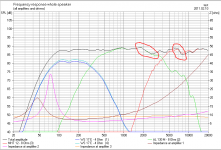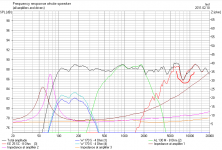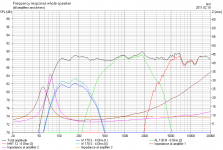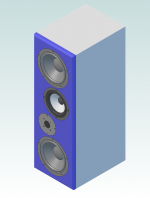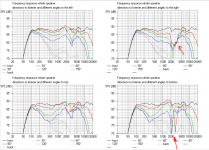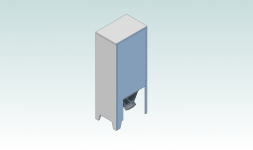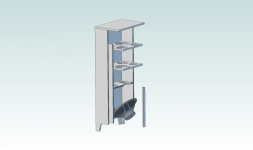It been a long time since I've posted anything. Lately a local forum had a lengthy discussion on loudspeakers and now I have this urge to finally build something in that direction.
Long long time ago I've had this idea to build a 4 way active system, but lack of experience and cash + time meant that it still sits on the drawing board (Visaton MHT12 ribbon tweeter, Peerless HDS 134 mids, 2x Visaton WS20e bass, Peerless Resolution R15 sub). As the time passed I understood that I'm jumping a bit over my head here. I'm living in a small room, and full-fledged floorstanding or horn or open-baffle speakers are out of the question. I already own Peerless Resolution R15 subwoofer and planning on keeping it.
Right now I'm weighing the following options:
The drivers will be mostly Visaton (pricing and ease of access).
I'm aiming for dry, accurate, 'monitor' sound.
Tweeter:
Visaton MHT12 ( Visaton - Lautsprecher und Zubehör, Loudspeakers and Accessories )
Visaton KE25SC ( Visaton - Lautsprecher und Zubehör, Loudspeakers and Accessories )
The big question - which one ?
Ribbons are known for their 'airiness', transparent, well defined sound, BUT reviews from Zaph aren't that good ( Zaph|Audio ), however further reading leaves me confused, some say meh, the distortion products aren't heard, as they lay out of the audio band, some say no, it's no good. Ceramic drivers on other hand have mostly favorable reviews, good distortion figures, good waterfall diagrams, etc. ( Visaton KE25SC ).
Both drivers have good reviews among people who build around them.
Or maybe I just order a fabric dome and thats that ?
Anyhow, I plan to cross the tweeter at 3-4kHz - out of the speech band.
Midrange:
I've been thinking about Peerless HDS 134, but its discontinued.
Another question is - should I go 2 way + sub or 3 way + sub, 2 way means I should have a bigger midrange and cross it lower in both tweeter and sub bands, 3 way means another speaker is needed and in that case necessity of the subwoofer is question.
Midrange will be used in 300Hz to 3-4Khz range. I'm thinking about metal cones as their behaviour is well defined up to break-up frequency, distortion is low and these drivers shown low distortion.
Visaton AL130m ( Visaton - Lautsprecher und Zubehör, Loudspeakers and Accessories )
Visaton AL170 ( http://www.visaton.de/en/chassis_zubehoer/tiefton/al170_8.html )
Visaton TI100 ( Visaton - Lautsprecher und Zubehör, Loudspeakers and Accessories )
Bass:
Needed to cover 70-300Hz range. To keep enclosure small I plan on squeezing it into a smaller box using Linkwitz transform if needed. Maybe I'll use two. Visaton also has TIW series but those are bloody expensive.
Visaton W200S ( Visaton - Lautsprecher und Zubehör, Loudspeakers and Accessories )
Visaton WS17e ( Visaton - Lautsprecher und Zubehör, Loudspeakers and Accessories )
Subwoofer:
Peerless Resolution R15 ( http://www.arkada.com/items/Resoluton_5.pdf )
I'm planning another box for this puppy (probably 120l vented with pluggable port). No questions here.
Should I go 2 way and drag the small midrange down to lets say 100Hz or get additional drivers to cover the bass ? Or get a bigger midrange and cross the tweeter lower ? How can I extract most out of my sub.
System will be active - building amps is easier than finetuning passive crossovers, plus active has numerous advantages. Crossover will be Linkwitz-Riley 24dB/oct, also should I have second look at Duelung XO ( http://www.duelundaudio.com/downloads/Articles_Steen_Duelund/duelund-filter.pdf ) ?
Discuss.
Long long time ago I've had this idea to build a 4 way active system, but lack of experience and cash + time meant that it still sits on the drawing board (Visaton MHT12 ribbon tweeter, Peerless HDS 134 mids, 2x Visaton WS20e bass, Peerless Resolution R15 sub). As the time passed I understood that I'm jumping a bit over my head here. I'm living in a small room, and full-fledged floorstanding or horn or open-baffle speakers are out of the question. I already own Peerless Resolution R15 subwoofer and planning on keeping it.
Right now I'm weighing the following options:
The drivers will be mostly Visaton (pricing and ease of access).
I'm aiming for dry, accurate, 'monitor' sound.
Tweeter:
Visaton MHT12 ( Visaton - Lautsprecher und Zubehör, Loudspeakers and Accessories )
Visaton KE25SC ( Visaton - Lautsprecher und Zubehör, Loudspeakers and Accessories )
The big question - which one ?
Ribbons are known for their 'airiness', transparent, well defined sound, BUT reviews from Zaph aren't that good ( Zaph|Audio ), however further reading leaves me confused, some say meh, the distortion products aren't heard, as they lay out of the audio band, some say no, it's no good. Ceramic drivers on other hand have mostly favorable reviews, good distortion figures, good waterfall diagrams, etc. ( Visaton KE25SC ).
Both drivers have good reviews among people who build around them.
Or maybe I just order a fabric dome and thats that ?
Anyhow, I plan to cross the tweeter at 3-4kHz - out of the speech band.
Midrange:
I've been thinking about Peerless HDS 134, but its discontinued.
Another question is - should I go 2 way + sub or 3 way + sub, 2 way means I should have a bigger midrange and cross it lower in both tweeter and sub bands, 3 way means another speaker is needed and in that case necessity of the subwoofer is question.
Midrange will be used in 300Hz to 3-4Khz range. I'm thinking about metal cones as their behaviour is well defined up to break-up frequency, distortion is low and these drivers shown low distortion.
Visaton AL130m ( Visaton - Lautsprecher und Zubehör, Loudspeakers and Accessories )
Visaton AL170 ( http://www.visaton.de/en/chassis_zubehoer/tiefton/al170_8.html )
Visaton TI100 ( Visaton - Lautsprecher und Zubehör, Loudspeakers and Accessories )
Bass:
Needed to cover 70-300Hz range. To keep enclosure small I plan on squeezing it into a smaller box using Linkwitz transform if needed. Maybe I'll use two. Visaton also has TIW series but those are bloody expensive.
Visaton W200S ( Visaton - Lautsprecher und Zubehör, Loudspeakers and Accessories )
Visaton WS17e ( Visaton - Lautsprecher und Zubehör, Loudspeakers and Accessories )
Subwoofer:
Peerless Resolution R15 ( http://www.arkada.com/items/Resoluton_5.pdf )
I'm planning another box for this puppy (probably 120l vented with pluggable port). No questions here.
Should I go 2 way and drag the small midrange down to lets say 100Hz or get additional drivers to cover the bass ? Or get a bigger midrange and cross the tweeter lower ? How can I extract most out of my sub.
System will be active - building amps is easier than finetuning passive crossovers, plus active has numerous advantages. Crossover will be Linkwitz-Riley 24dB/oct, also should I have second look at Duelung XO ( http://www.duelundaudio.com/downloads/Articles_Steen_Duelund/duelund-filter.pdf ) ?
Discuss.
Go 2-way + sub; really no need to go 3-way - more money and crossover complexity.
With passive crossovers I would agree whole heartedly, but with active crossovers a lot of issues become simpler. A 3-way with a good mid covering from the midbass through the voice range can really make a nice sound-a kind of point source for the most important stuff.
If budget is not a huge problem, I would go 3-way actually. That offers the possibility of using drivers whose response extends PAST the crossover points. Another big plus is you can cut more lows out of each driver. For example, a 6" 2-way mating to a sub is straining to put out 80 Hz or whatever, and having a tough time trying to reach up to 3k-ish (with narrowing dispersion). If the mid becomes 4" and you add an 8" or 10" woofer, those problems can be significantly alleviated. The active crossovers mean you can easily adjust the levels if the drivers have different sensitivities.
In either case, what software do you have to check actual driver response and make summed response simulations? (i.e. LEAP and so forth).
As for the ribbon...well, they just have a different kind of sound characteristic. A kind of precision or something has been my experience. They used to be more beamy than a dome, but I think some newer ones actually have very even dispersion. I'd say try it. Especially if you go 3-way, the low end load on the ribbon is less of a problem. Of course some ribbons like the Ravens can go very low and have a lot of sensitivity; the price reflects this.
A 3-way with a good mid covering from the midbass through the voice range can really make a nice sound-a kind of point source for the most important stuff.
Exactly my point.
If budget is not a huge problem, I would go 3-way actually.
It always is.
If the mid becomes 4" and you add an 8" or 10" woofer, those problems can be significantly alleviated.
I'm thinking on keeping a AL130m mid, and sticking 2 6.5" on the bass. 8" or 10" ar rather large, I want a smaller box (bookshelf on steroids if you may).
The WS17E is asking to get there, they are cheap but not too sensitive. (price of 4 is less than 100eu)
In either case, what software do you have to check actual driver response and make summed response simulations? (i.e. LEAP and so forth).
Right now I'm playing with Boxsim ( Boxsim - Homepage ) and thinking about getting a measuring mike (no reliable source for panasonic WM61 though).
My room is smallish. 12 x 14 approximately. I have my speakers away from the walls, so they are roughly 7 feet from me. My sub is a ported 15". For this type of setup, I think it's a coin toss as to whether a 3-way offers much advantage over a 2-way. I have 2-ways currently, but plan to build a small 3-way pretty soon using this Peerless HDS driver for a mid. http://www.parts-express.com/pdf/264-1074s.pdf
To save a few bucks, you could make a hybrid speaker. Go passive from woofer to mid, and active to the tweeter. Use active EQ to adjust your baffle step, and to EQ the blend with the sub, and tweeter. If you are going to be less than 8 feet from the speaker, I'd keep driver spacing very tight.
To save a few bucks, you could make a hybrid speaker. Go passive from woofer to mid, and active to the tweeter. Use active EQ to adjust your baffle step, and to EQ the blend with the sub, and tweeter. If you are going to be less than 8 feet from the speaker, I'd keep driver spacing very tight.
I'd say go 3 way. You already has a 2 way, why not proceed up the food chain? One driver for each frequency range, all in one package, no need to find space to put that sub in a smallish room, and a more elegant approach - the wife shld be happier too.
Tony Gee has a nice RS aluminum 3 way speaker that might give you some idea: Humble Homemade Hifi
Troels' 3 way classic in 1" - 4" - 8" format: 3-Way Classic
Tony Gee has a nice RS aluminum 3 way speaker that might give you some idea: Humble Homemade Hifi
Troels' 3 way classic in 1" - 4" - 8" format: 3-Way Classic
Hi VEC7OR,
From what I have learned: I would build two 3-way full range speakers. A second Peerless Resolution R15 would be one incremental option. I would consider a "full range" 6" or 8" for a high detail wide bandwidth midbass (LR4 80-120Hz xover) and LR4 cross the tweeter at the 90 degree directivity frequency of that midbass (typically 1500-2000 Hz). An SPL of 93-94 db/watt is important to capture musical detail at low volumes in a small room.
Bass location demands stereo subs: Several papers have been published where both measurement and double blind tests prove that bass near 60Hz can be spacially located within the room. I find that the lowest piano octave on stereo woofers creates a realistic 3D "single piano" image, but images like two different pianos with a single sub.
An WMT with an efficienct wide bandwidth midbass provides detailed coherent sound at short listening distances. 93-94 db/watt is involving and magical. 88 db/watt is dull until the volume is cranked up to DEFF. An MTM delivers "fuzzy" midrange when compared to a high quality single full range.
Look at using a 6"-8" full range with ~94db/watt efficiency as a wide bandwidth midbass. We love our MLTL Tang Band W8-1808 bedroom speakers. (9.4grams Mms, 5mm Xmax, 45Hz Fs). A clever shape, fiberglass stuffed, large midrange cabinet that absorbs rear cone energy is important. There are good reasons why several full range forums exist.
The SB29RDCN tweeter is my favorite small 540Hz Fs, 94db/watt tweeter. A low Fs tweeter is required for 1500-2000Hz, 90 degree directivity crossover.
Anyway, that's what my ears have learned.
From what I have learned: I would build two 3-way full range speakers. A second Peerless Resolution R15 would be one incremental option. I would consider a "full range" 6" or 8" for a high detail wide bandwidth midbass (LR4 80-120Hz xover) and LR4 cross the tweeter at the 90 degree directivity frequency of that midbass (typically 1500-2000 Hz). An SPL of 93-94 db/watt is important to capture musical detail at low volumes in a small room.
Bass location demands stereo subs: Several papers have been published where both measurement and double blind tests prove that bass near 60Hz can be spacially located within the room. I find that the lowest piano octave on stereo woofers creates a realistic 3D "single piano" image, but images like two different pianos with a single sub.
An WMT with an efficienct wide bandwidth midbass provides detailed coherent sound at short listening distances. 93-94 db/watt is involving and magical. 88 db/watt is dull until the volume is cranked up to DEFF. An MTM delivers "fuzzy" midrange when compared to a high quality single full range.
Look at using a 6"-8" full range with ~94db/watt efficiency as a wide bandwidth midbass. We love our MLTL Tang Band W8-1808 bedroom speakers. (9.4grams Mms, 5mm Xmax, 45Hz Fs). A clever shape, fiberglass stuffed, large midrange cabinet that absorbs rear cone energy is important. There are good reasons why several full range forums exist.
The SB29RDCN tweeter is my favorite small 540Hz Fs, 94db/watt tweeter. A low Fs tweeter is required for 1500-2000Hz, 90 degree directivity crossover.
Anyway, that's what my ears have learned.
My Mission 701's are two way with a 6 inch bass/mid driver. By itself it sounds nice and has decent LF but misses the weight in some recordings.
I added a sub and I use an electronic crossover for the Missions ( HPF - 12 dB/oct) and a LPF(24dB/oct) for the 12 inch sub ( mono ). It sounds great and can really go loud with plenty of punch. The 701 was sealed to get an acoustic -12dB/octave response and so it has an overall -24dB/octave response. Main amp is 60+60watts and sub amp is 120 watts.
I might add that I find that subs must always kick in as low as possible . It's much easier to integrate it properly. Mine is crossed over at about 80Hz. I've tried up to 150Hz with smaller satellite speakers but it doesn't integrate well.
Better you let your main speakers work well to just under 100Hz.
With stereo subs sitting under/near the main speakers things would be different of course. Here you could get away with a much higher frequency though if you go too high it can smear the image. Keeping it low is always better.
I added a sub and I use an electronic crossover for the Missions ( HPF - 12 dB/oct) and a LPF(24dB/oct) for the 12 inch sub ( mono ). It sounds great and can really go loud with plenty of punch. The 701 was sealed to get an acoustic -12dB/octave response and so it has an overall -24dB/octave response. Main amp is 60+60watts and sub amp is 120 watts.
I might add that I find that subs must always kick in as low as possible . It's much easier to integrate it properly. Mine is crossed over at about 80Hz. I've tried up to 150Hz with smaller satellite speakers but it doesn't integrate well.
Better you let your main speakers work well to just under 100Hz.
With stereo subs sitting under/near the main speakers things would be different of course. Here you could get away with a much higher frequency though if you go too high it can smear the image. Keeping it low is always better.
Last edited:
If it's a small-ish room, you may get all the bass you need with a small two-way tower. It won't have as much big-bass slam as a three-way or active sub, but if the room is small it's worth considering. I've built two-way towers which have gone down to 37Hz without reaching maximum linear excursion at 50w.AJ
I'm not sure what you mean by "smaller": total volume, or shape.I'm thinking on keeping a AL130m mid, and sticking 2 6.5" on the bass. 8" or 10" ar rather large, I want a smaller box (bookshelf on steroids if you may).
If total volume, you are kind of misunderstanding perhaps. To keep excursion lower at a given frequency and SPL, you need more cone area. The box volume transforms through this cone area driving up the resonance. So more or less you will just end up with a certain volume of box whether you use 8"/10" or 2x6.5" (whose total cone area I think would be between the 8" and 10"). Of course, individual parameters might happen to work out better for one of those combos, but using the smaller drivers won't guarantee a smaller box at all. On the other hand, the shape of the box can certainly be different, if that's what you have in mind.
Well, one beauty of active crossovers in a three way with driver overlap is this won't be as critical. You don't have to worry about the impedance, just the frequency response, and if the drivers overlap well the exact filter settings won't be as critical.Right now I'm playing with Boxsim ( Boxsim - Homepage ) and thinking about getting a measuring mike (no reliable source for panasonic WM61 though).
I'm not sure what you mean by "smaller": total volume, or shape.
By smaller I mean slimmer, right now I plan to attach the speakers to the walls of the room.
Well, one beauty of active crossovers in a three way with driver overlap is this won't be as critical. You don't have to worry about the impedance, just the frequency response, and if the drivers overlap well the exact filter settings won't be as critical.
Exactly.
Right now I'm thinking about going KE25SC + AL130m + 2x W170s.
I also attach a few simulation graphs.
One thing bothers me - to correctly sum the responses some crossover slopes have to be asymmetric.
As for now I'm settling no the for the following XO points:
sub to bass - 70Hz 24db/oct
bass to mid - 300Hz 24db/oct
mid to high - 3300Hz 24db/oct mid, 3300 12db/oct high. - steeper slope on the mid side as to avoid dragging cone breakup into the main responce.
If you are going to be less than 8 feet from the speaker, I'd keep driver spacing very tight.
More like 5 feet or so. I think about tall/slim box with WMTW arrangement.
Attachments
Last edited:
small room I would go two way no sub. With just one sub its very hard to get flat bass. Have you considered going just one way?
Alpair 12 Driver | Markaudio
This way you avoid problems from sitting close to the speakers and as you are so close to the speakers the lower maximum volume isn't an issue.
Alpair 12 Driver | Markaudio
This way you avoid problems from sitting close to the speakers and as you are so close to the speakers the lower maximum volume isn't an issue.
small room I would go two way no sub. With just one sub its very hard to get flat bass. Have you considered going just one way?
Alpair 12 Driver | Markaudio
This way you avoid problems from sitting close to the speakers and as you are so close to the speakers the lower maximum volume isn't an issue.
The room is 3x4x2.8, so sitting not close to the speakers is an issue, listening position is in the apex of a rather wide triangle (90° or so), with speakers pointing at the ears, it works well but I want to make it rather universal.
Fullrange is rather tempting, but lack of proper bass ( = big enclosure, or horn or something else) is a downer, also knowing that they have high sensitivity asks for a huge PA driver to back the low end, with a huge box...
Two subs is awesome, but my room isn't that large. I think EQ'ing my way into the flat bass land is another option.
This is how I envision it. I wish these could be built as fast as I can draw...
So far box is 70x24x30 (OD), inner volume is around 45l.
I've input box data into the boxsim and I see that I have a rather ugly cancellation problems appearing at arrow positions. Should I do anything about it or it is the consequences of acoustic summation ?
So far box is 70x24x30 (OD), inner volume is around 45l.
I've input box data into the boxsim and I see that I have a rather ugly cancellation problems appearing at arrow positions. Should I do anything about it or it is the consequences of acoustic summation ?
Attachments
Last edited:
One thing bothers me - to correctly sum the responses some crossover slopes have to be asymmetric.
As for now I'm settling no the for the following XO points:
sub to bass - 70Hz 24db/oct
bass to mid - 300Hz 24db/oct
mid to high - 3300Hz 24db/oct mid, 3300 12db/oct high. - steeper slope on the mid side as to avoid dragging cone breakup into the main responce.
Those don't seem asymmetric. Sub lowpass is already built-in? What slope?
The woofers in a sealed box are already 12 dB, so you'd just add 6 or 12 on top of that to match the sub. BUT, like in car audio, fooling around with spreading the crossover points may give a better response.
Likewise the other highpass would usually be shallower than the lowpass, unless there's a lot of overlap.
The cancellation...phase problems???? Just a guess, I didn't look in huge detail.
Right now I'm reconsidering 2 way + sub.
I think I'm settled on the tweeter, it will be Visaton KE25SC, on the bass-midrange folks at local forum suggest to try out Seas U18rnx/p, it has enough low end extension and good up to 5kHz, any comments on that one ?
Browsing local PA gear shops I've stumbled upon DCX2496, not that I see it for the first time, its just the pricing dropped considerably, I'm seriously considering buying this unit, as it solves all of the XO problems in one attractive/moddable package, furthermore if I upgrade the system in one way or another it stays, I also have Behringer Ultrabass EX-1200, it can take the care of the subwoofer in the case I decide to go 3 way + sub with DCX2496.
As for now I think I'll start from the ground up - I'll rebuild the subwoofer enclosure, along with an amp for it (TAS5630 mono), calculate needed power for other bands and start design of the amps, probably the LM3886 etc, along the way selecting other drivers I'll need.
I think I'm settled on the tweeter, it will be Visaton KE25SC, on the bass-midrange folks at local forum suggest to try out Seas U18rnx/p, it has enough low end extension and good up to 5kHz, any comments on that one ?
Browsing local PA gear shops I've stumbled upon DCX2496, not that I see it for the first time, its just the pricing dropped considerably, I'm seriously considering buying this unit, as it solves all of the XO problems in one attractive/moddable package, furthermore if I upgrade the system in one way or another it stays, I also have Behringer Ultrabass EX-1200, it can take the care of the subwoofer in the case I decide to go 3 way + sub with DCX2496.
As for now I think I'll start from the ground up - I'll rebuild the subwoofer enclosure, along with an amp for it (TAS5630 mono), calculate needed power for other bands and start design of the amps, probably the LM3886 etc, along the way selecting other drivers I'll need.
Here's a woofer for a small 3-way.
It's 90 dB. Needs .5 cu-ft. Sealed F3 of 70 hz.
https://www.madisound.com/store/product_info.php?cPath=45_228_257&products_id=1614
It's 90 dB. Needs .5 cu-ft. Sealed F3 of 70 hz.
https://www.madisound.com/store/product_info.php?cPath=45_228_257&products_id=1614
Last edited:
Here's a woofer for a small 3-way.
It's 90 dB. Needs .5 cu-ft. Sealed F3 of 70 hz.
https://www.madisound.com/store/product_info.php?cPath=45_228_257&products_id=1614
Considered.
Continuing, on with the sub enclosure - as the driver requires rather large box, I'm planning to make it rather slim ant tall, there is a piece of furniture which is 36cm wide, so the enclosure will be roughly 50x36x120cm(with more precise dimensions later), as shown on pics.
Attachments
- Status
- This old topic is closed. If you want to reopen this topic, contact a moderator using the "Report Post" button.
- Home
- Loudspeakers
- Multi-Way
- 2-way + sub or 3-way + sub in a smallish room
